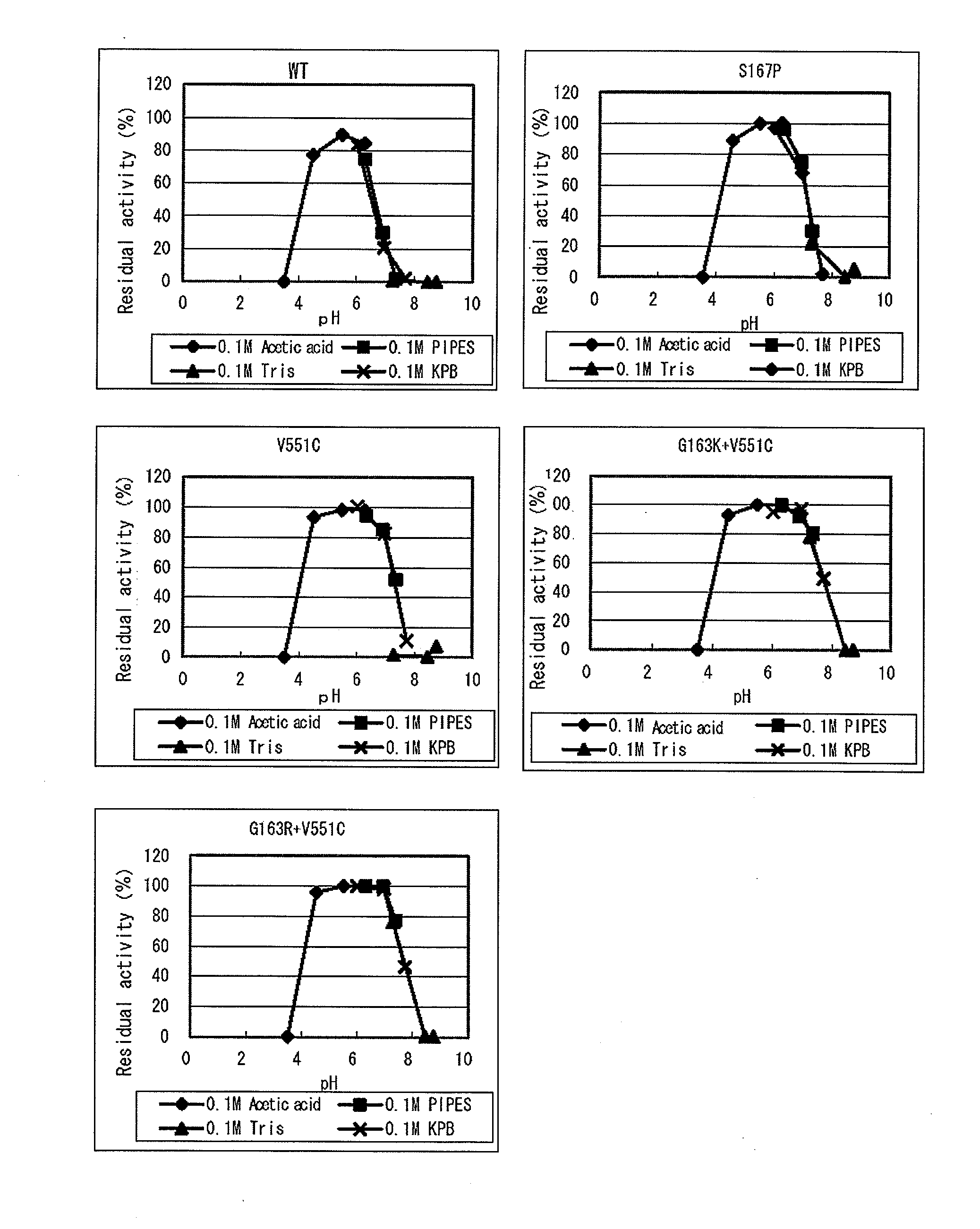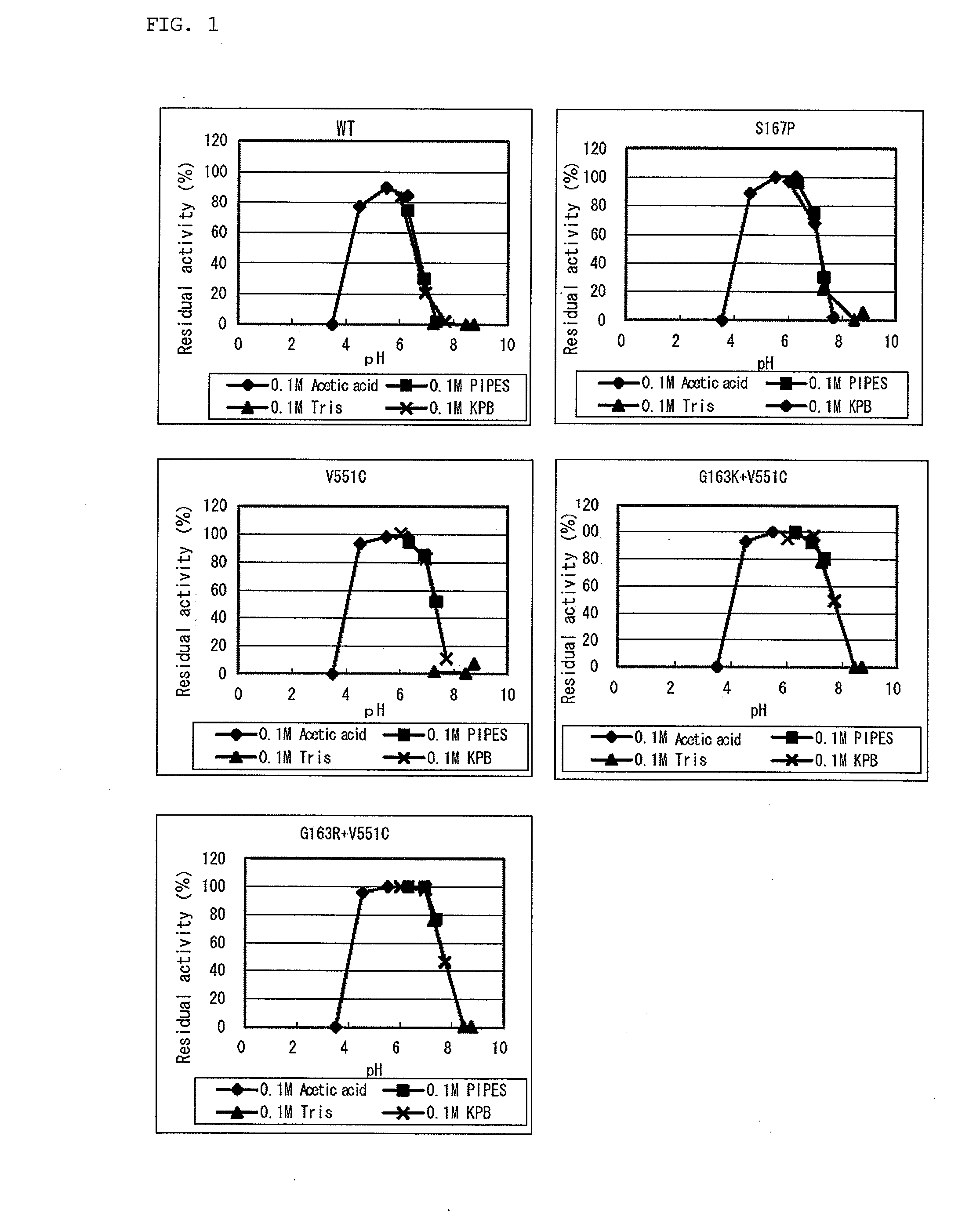Modified flavin adenine dinucleotide dependent glucose dehydrogenase
a technology of glucose dehydrogenase and flavin adenine dinucleotide, which is applied in the field of modified flavin adenine dinucleotide dependent glucose dehydrogenase, can solve the problems of deteriorating the accuracy of measurement values, poor stability and cumbersomeness, and adverse effects of dissolved oxygen on measured values, so as to reduce the amount of enzymes used, improve measurement precision, and reduce the effect of heat-inactivation of enzym
- Summary
- Abstract
- Description
- Claims
- Application Information
AI Technical Summary
Benefits of technology
Problems solved by technology
Method used
Image
Examples
experimental example 1
Estimation of Aspergillus-oryzae-Derived Glucose Dehydrogenase (Hereinafter Also Referred to as “AOGDH”) Gene
[0029]1. Obtainment of Aspergillus-oryzae-Derived GDH
[0030]A lyophilized sample of an Aspergillus oryzae TI strain was inoculated into potato dextrose agar culture medium (product of Difco Laboratories Incorporated) and incubated at 25° C. for renaturation. The renatured hyphae on each plate were recovered together with the agar, and suspended in filter-sterilized water. Six liters of production medium (1% malt extract, 1.5% soybean peptide, 0.1% MgSO4-heptahydrate, 2% glucose, and pH 6.5) was prepared in two 10-liter jar fermenters, sterilized in an autoclave for 15 minutes at 120° C., and allowed to cool. The above cell suspension was inoculated into the medium, and incubated at 30° C. under aerobic conditions while stirring. The incubation was terminated 64 hours after initiation; the cells were removed using filtration to collect a filtrate having GDH activity. The collec...
experimental example 2
Obtainment of Aspergillus-oryzae-Derived Glucose Dehydrogenase Gene and Introduction Thereof to E. coli
[0035]To obtain an AOGDH gene, mRNA was prepared from cells of an Aspergillus oryzae TI strain, and cDNA was synthesized. Two oligo DNAs represented by SEQ. ID Nos. 39 and 40 were synthesized. The AOGDH gene was then amplified with the prepared cDNA as a template, using KOD Plus DNA polymerase (product of Toyobo Co., Ltd.). The DNA fragments were digested with restriction enzymes NdeI and BamHI, and inserted into the NdeI-BamHI site of pBluescript (phagemid into which an NdeI site is introduced so that atg of the NdeI recognition sequence corresponds to LacZ translation initiation codon “atg”) to construct a recombinant plasmid. Using this recombinant plasmid, Escherichia coli DH5α (product of Toyobo Co., Ltd.) was transformed. The plasmid was extracted from the transformant in the standard manner, and the base sequence of the AOGDH gene was determined (SEQ. ID No. 41). As a resul...
experimental example 3
Introduction of Aspergillus-oryzae-Derived Glucose Dehydrogenase (Hereinafter Referred to as “AOGDH”) Gene to E. coli
[0036]When taking FADGDH after signal peptide cleavage as mFADGDH, S2 refers to mFADGDH having a single amino acid length extension at the N terminal due to the addition of only M.
[0037]PCR was carried out using the oligonucleotide of SEQ ID No.43 as an N-terminal primer in combination with the primer of SEQ ID No.44, and a recombinant plasmid having the DNA sequence (SEQ ID No. 1) coding for S2 was constructed in the same manner, and the transformant was similarly obtained.
[0038]The plasmid containing the DNA sequence of the modified FADGDH was subjected to DNA sequencing and reexamined for the accuracy.
[0039]The transformant was incubated for 1 to 2 days in a 10-liter jar fermenter loaded with TB culture medium. After recovering cells from each culture phase, the recovered cells were ultrasonically disrupted to investigate GDH activities. The GDH productivity was i...
PUM
| Property | Measurement | Unit |
|---|---|---|
| Fraction | aaaaa | aaaaa |
| Fraction | aaaaa | aaaaa |
| Fraction | aaaaa | aaaaa |
Abstract
Description
Claims
Application Information
 Login to View More
Login to View More - R&D
- Intellectual Property
- Life Sciences
- Materials
- Tech Scout
- Unparalleled Data Quality
- Higher Quality Content
- 60% Fewer Hallucinations
Browse by: Latest US Patents, China's latest patents, Technical Efficacy Thesaurus, Application Domain, Technology Topic, Popular Technical Reports.
© 2025 PatSnap. All rights reserved.Legal|Privacy policy|Modern Slavery Act Transparency Statement|Sitemap|About US| Contact US: help@patsnap.com


